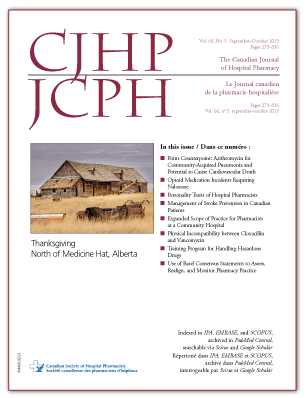Retrospective Analysis of Opioid Medication Incidents Requiring Administration of Naloxone
DOI:
https://doi.org/10.4212/cjhp.v66i5.1284Keywords:
medication incident, medication safety, opioid, naloxone, incident lié au médicament, sécurité des médicaments, opioïdeAbstract
ABSTRACT
Background: Opioid analgesics are high-alert medications known to cause adverse drug events.
Objectives: The purpose of this study was to determine the cause of opioid incidents requiring administration of naloxone, an opioid reversal agent. The specific objectives were to determine the number of opioid incidents and the proportion of incidents documented through occurrence reporting and to characterize the incidents by phase in the medication-use process, by type of incident, and by drug responsible for toxic effects.
Methods: A retrospective chart analysis was conducted using records from 2 acute care centres in the Regina Qu’Appelle Health Region. The study included inpatients who received naloxone for reversal of opioid toxicity resulting from licit, in-hospital opioid use. Cases were classified as preventable or nonpreventable. Preventable cases were analyzed to determine the phase of the medication-use process during which the incident occurred. These cases were also grouped thematically by the type of incident. The drug most likely responsible for opioid toxicity was determined for each case. The proportion of cases documented by occurrence reporting was also noted.
Results: Thirty-six cases involving administration of naloxone were identified, of which 29 (81%) were deemed preventable. Of these 29 preventable cases, the primary medication incident occurred most frequently in the prescribing phase (23 [79%]), but multiple phases were often involved. The cases were grouped into 6 themes according to the type of incident. Morphine was the drug that most frequently resulted in toxic effects (18 cases [50%]). Only two of the cases (5.6%) were documented by occurrence reports.
Conclusion: Preventable opioid incidents occurred in the acute care centres under study. A combination of medication safety initiatives involving multiple disciplines may be required to decrease the incidence of these events and to better document their occurrence.
RÉSUMÉ
Contexte : Les analgésiques opioïdes sont des médicaments qui commandent une vigilance élevée, connus pour les événements indésirables qu’ils entraînent.
Objectifs : Le but de cette étude était de déterminer la cause des incidents attribuables aux opioïdes nécessitant l’administration de naloxone, un antidote des opioïdes. Les objectifs précis étaient de déterminer le nombre d’incidents attribuables aux opioïdes et la proportion d’incidents constatés par comptes rendus d’événements et de caractériser les incidents selon la phase dans le processus de distribution des médicaments, le type d’incident et l’agent responsable des effets toxiques.
Méthodes : Une analyse rétrospective des dossiers médicaux des patients a été menée dans deux centres de soins de courte durée de la Regina Qu’Appelle Health Region. L’analyse incluait les patients hospitalisés ayant reçu de la naloxone pour neutraliser la toxicité opioïde attribuable à l’utilisation intrahospitalière licite d’opioïdes. Les cas d’incidents ont été classés comme étant évitables ou non évitables. Les cas évitables ont été analysés afin de déterminer la phase du processus de distribution des médicaments durant laquelle l’incident est survenu. Ces cas ont également été regroupés par type d’incident. Le médicament le plus susceptible d’avoir causé une toxicité opioïde a été déterminé pour chaque cas. La proportion de cas constatés par comptes rendus d’événements a aussi été notée.
Résultats : On a relevé 36 cas nécessitant l’administration de naloxone, dont 29 (81 %) ont été jugés évitables. De ces 29 cas évitables, le principal incident lié au médicament est survenu le plus souvent dans la phase de prescription (23 [79 %]), mais plusieurs phases étaient souvent en cause. Les cas ont été regroupés en six types d’incidents. La morphine était l’agent ayant le plus souvent entraîné des effets toxiques (18 cas [50 %]). Seulement deux des cas (5,6 %) ont été constatés par comptes rendus d’événements.
Conclusion : Des incidents évitables liés aux opioïdes sont survenus dans les deux centres de soins de courte durée faisant l’objet de la présente analyse. Une combinaison de mesures faisant appel à plusieurs disciplines pour améliorer la sécurité des médicaments pourrait être nécessaire afin de réduire l’incidence de tels événements et de constater leur occurrence.
Downloads
Published
Issue
Section
License
Copyright © Canadian Society of Healthcare-Systems Pharmacy.
After publication of a manuscript in the CJHP, the authors of the manuscript must obtain written permission from the CSHP (publications@cshp.ca) before reproducing any text, figures, tables, or illustrations from the work in future works of their own. If a submitted manuscript is declined for publication in the CJHP, all said rights shall revert to the authors. Please note that any forms (e.g., preprinted orders and patient intake forms) used by a specific hospital or other health care facility and included as illustrative material with a manuscript are exempt from this copyright transfer. The CJHP will require a letter from the hospital or health care facility granting permission to publish the document(s).










